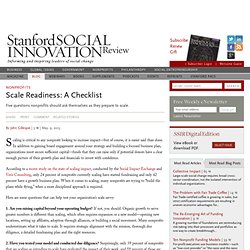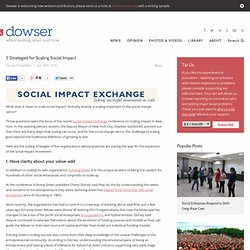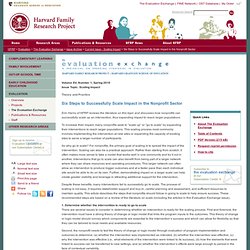

Social Entrepreneurs' Tricky Issues of Sustainability and Scale - Nina Dudnik. By Nina Dudnik | 10:13 AM October 18, 2010 Editor’s note: This week, in the run-up to the 2010 PopTech conference, we’ll be running posts from PopTech’s 2010 class of Social Innovation Fellows.

This is the first in that series. When you start any sort of venture, the most frequently asked questions center around two words: sustainability and scale. Scalability is the ability to increase revenues while your marginal costs decrease with each unit sale. In other words: developing a product people actually want and figuring out how to stamp out lots of them for lower costs while selling ever more of them.
We don’t just make products or deliver services; we’re supposed to generate real impact on complex societal problems. That kind of work embodies the phrase “high touch” and it flies in the face of that conventional definition of scalability. To Grow, Social Enterprises Must Play by Business Rules - Alan Hirzel. By Alan Hirzel | 2:07 PM January 9, 2013 We can’t ask social enterprises to have a big impact if they can’t get the resources they need to grow bigger.

In Britain, for example, fewer than 10% of the tens of thousands of social enterprises generate more than £1 million in revenue. Why is that? One reason is that the scrappy, entrepreneurial approach that characterizes many of these organizations starts to break down as they pass that threshold. Normal business complexity sets in. And these organizations face a quandary—they are too small to support the growth they need and the impact they want to have. For-profit companies in the same situation can turn to a robust venture capital community that is focused on providing the management, financing and strategy that innovative companies need to scale up quickly. Hoping to fill this need, my firm, Bain & Company and six other partners founded Social Business Trust (SBT) in the U.K.
Scale Readiness: A Checklist. Five questions nonprofits should ask themselves as they prepare to scale.

Scaling is critical to any nonprofit looking to increase impact—but of course, it is easier said than done. In addition to gaining board engagement around your strategy and building a focused business plan, organizations must secure sufficient capital—funds that they can raise only if potential donors have a clear enough picture of their growth plan and financials to invest with confidence.
According to a recent study on the state of scaling impact, conducted by the Social Impact Exchange and Veris Consulting, only 24 percent of nonprofits currently scaling have started fundraising and only 42 percent have a growth business plan. When it comes to scaling, many nonprofits are trying to “build the plane while flying,” when a more disciplined approach is required.
New Research: If You Want To Scale Impact, Put Financial Results First - Linda Rottenberg and Rhett Morris. Entrepreneurs who lead for-profit, social enterprises face a unique challenge: they must simultaneously create financial value for their investors and social value for those they seek to serve.

Having two missions, however, sometimes creates conflicts that can slow companies’ growth. Endeavor Insight, the research arm of our organization Endeavor, has found that the way that entrepreneurs who lead social enterprises make tradeoffs between social and financial goals is a critical factor in determining the degree to which their companies will grow.
5 Strategies for Scaling Social Impact. What does it mean to scale social impact?

And why exactly is scaling important to the social change sector? Those questions were the focus of the recent Social Impact Exchange conference on Scaling Impact in New York. In the opening plenary session, the Deputy Mayor of New York City, Stephen Goldsmith, pointed out that there are many ways that scaling can occur, and for the social change sector, the challenge of scaling goes beyond the traditional definition of growing in size. Here are the scaling strategies of five organizations whose practices are paving the way for the expansion of the social impact movement: 1. In addition to scaling its own organization, Echoing Green is in the unique position of being the catalyst for hundreds of other social enterprises and nonprofits to scale up. At the conference, Echoing Green president Cheryl Dorsey said they do this by understanding the needs and concerns of the entrepreneurs they serve. 2. 3. 4.
Single Stop works to fix a broken system. 5. Www.ired.org/modules/infodoc/cache/files/french/changer_d__chelle1.pdf. Six Steps to Successfully Scale Impact in the Nonprofit Sector / Current Issue - Scaling Impact / Issue Archive / The Evaluation Exchange / Evaluation. Erin Harris of HFRP reviews the literature on this topic and discusses how nonprofits can successfully scale up an intervention, thus expanding impact to reach larger populations.

Scaling Social Entrepreneurial Impact: The SCALERS Model / Current Issue - Scaling Impact / Issue Archive / The Evaluation Exchange / Evaluation. Paul N.

Bloom and Aaron K. Chatterji of Duke University discuss a model that they have developed to conceptualize scaling impact for social entrepreneurs. Scaling social impact has become a major challenge for social entrepreneurs—individuals who start up and lead new organizations or programs to address social problems using change strategies that differ from those used in the past.
Social entrepreneurs who achieve initial success with their ideas often have difficulty replicating these ideas on a larger scale. To determine what factors contribute to success when social entrepreneurs scale up their efforts, we developed a model that identifies seven organizational capabilities, or “drivers.” Staffing refers to the organization’s effectiveness at filling its labor needs—including managers, staff, and volunteers—with people who have the right skills for their positions. Replicating refers to an organization’s effectiveness in reproducing its programs and initiatives. Paul N. Aaron K. 1. Setting the Stage for First-Stage Scaling. Social enterprises face many challenges to scaling, and preparing them with the appropriate team, culture, and systems is a critical first step in the process.

Part one of a three-part series. Viitor Plus, a social enterprise in Romania that produces environmentally friendly shopping bags to educate consumers about conservation, faced a dilemma when contemplating its growth strategy. To multiply its impact, the enterprise wanted to reach as many consumers as possible by ramping up production. At the same time, the board of directors was committed to employing at-risk employees who had only partial access to the job market. This caused incessant production challenges, as employees were limited by the tasks they could perform and number of hours they could be on the job.